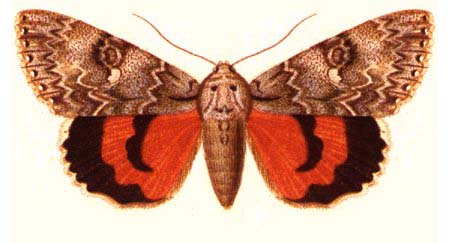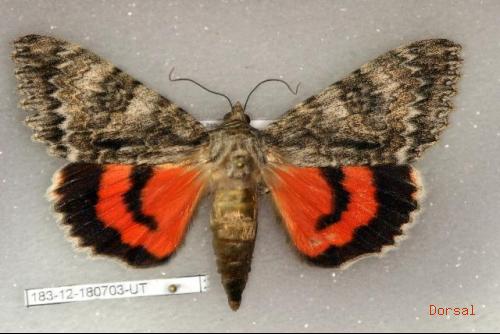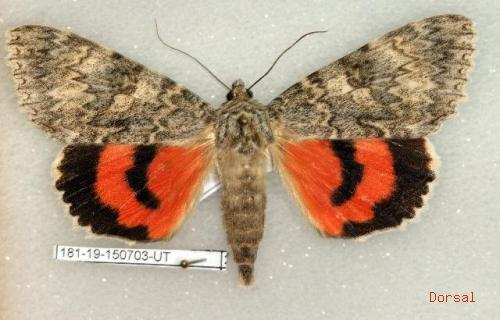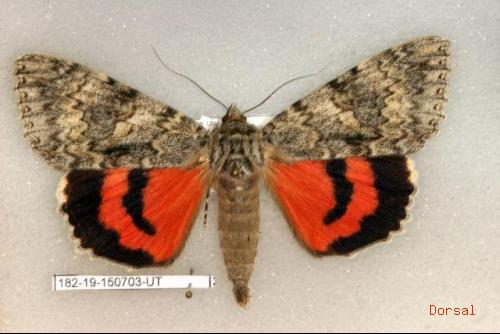Catocala pura = semirelicta
kah-TOCK-uh-lahmPEW-ruh
Hulst, 1880

Catocala pura = semirelicta, Hampson plate.
This site has been created by
Bill Oehlke at oehlkew@islandtelecom.com
Comments, suggestions and/or additional information are welcomed by Bill.
| TAXONOMY:
Superfamily: Noctuoidea
Family: Noctuidae
Group: Noctuinina
Subfamily: Catocalinae
Genus: Catocala, Schrank, 1802
| |
MIDI MUSIC
"Moon River"
copyright C. Odenkirk
MIDI CITYON.OFF
<bgsound src="moon.mid" LOOP=FOREVER>
|
DISTRIBUTION:
Catocala pura = semirelicta
(wingspan: mm),
flies in Colorado, Montana and Utah (Wasatch Mountains) and into California.
For a more detailed range, visit Catocala semirelicta.

Catocala pura = semirelicta, Utah, All Leps Barcode of Life.
On the forewing, the subreniform spot is white and open and the
antemedial, postmedial and subterminal lines are regularly
zig-zagged with no greatly protruding spikes. There is a narrow
basal dash, sometimes extending
into the median area.

Catocala pura = semireclicta, Utah, All Leps Barcode of
Life.
The inner black band of the hindwing is relatively even and narrow and
ends well before the inner margin. Hindwing fringe is white from the
apex to the anal angle where it turns reddish brown. The coloured
bands are red. There is usually some bleeding of the salmon red into the
white fringe, especially at the apex.

Catocala pura = semirelicta, Utah, All Leps Barcode of
Life.
Catocala nevadensis and Catocala pura
are now (2010) considered to be synonymous of Catocala semirelicta.
FLIGHT TIMES AND PREFERRED FOOD PLANTS:
Catocala pura = semirelicta are on the wing in July and August.
The Catocala pura = semirelicta caterpillar feeds on
Populus fremontii.
ECLOSION:
Adults eclose from pupae at soil surface.
SCENTING AND MATING:
Catocala pura= semirelicta females
emit an airbourne pheromone and males use their antennae to track the
scent plume.
EGGS, CATERPILLARS, COCOONS, AND PUPAE:
Eggs are deposited on
tree bark in the fall and hatch the following spring.
Larval Food Plants
Listed below are primary food plant(s) and alternate food plants.
It is hoped that this alphabetical listing followed by the common
name of the foodplant will prove useful. The list is not exhaustive,
although some species seem very host specific.
Experimenting with closely related foodplants is worthwhile.
Populus fremontii.......
|
Cottonwood
|
Use your browser "Back button to return to the previous page.
Goto Main Catocala Index
This page is brought to you by Bill Oehlke and the
WLSS. Pages are on space rented from Bizland. If you would like to become a "Patron of the Sphingidae/Catocala Sites",
contact Bill.
Please send sightings/images to Bill. I will do my best to respond to requests for identification help.
Enjoy one of nature's wonderments: Live Saturniidae (Giant Silkmoth) cocoons.

|

To show appreciation for this site, click on the flashing
butterfly to the left, a link to many worldwide insect sites. |





